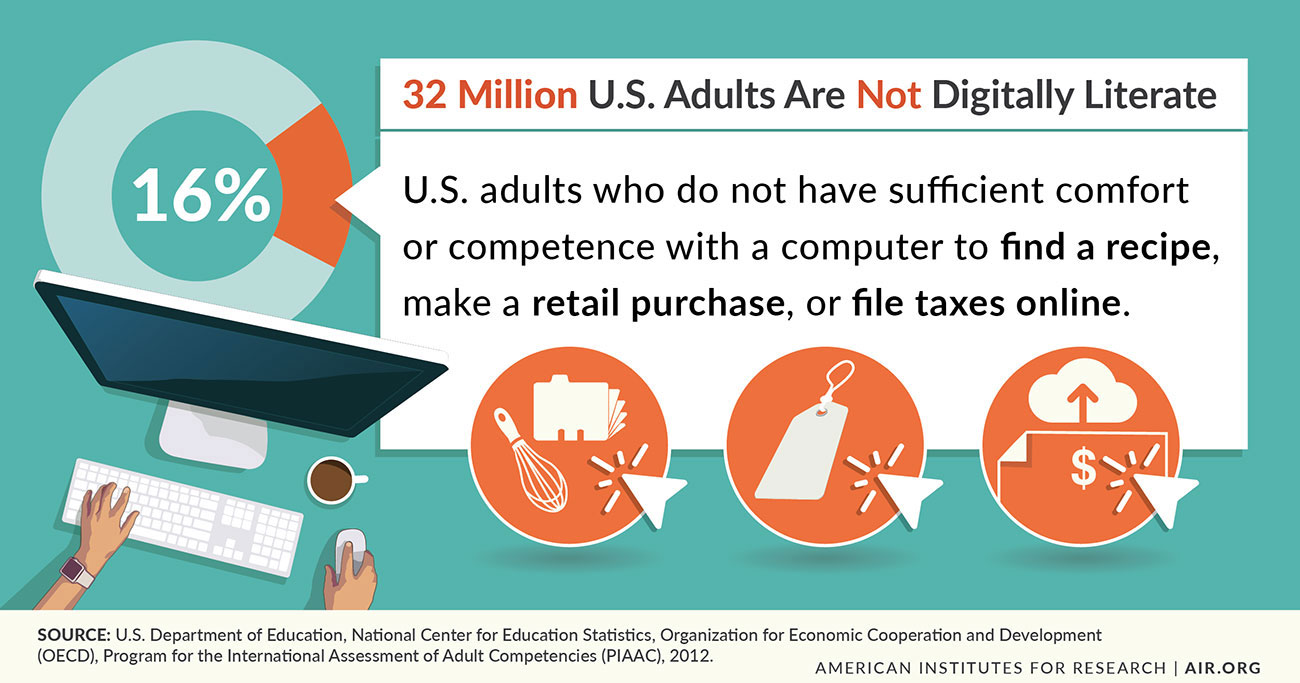Do U.S. Adults Have the Skills Needed to Thrive in the 21st Century? Four PIAAC Studies by AIR
Successfully navigating work and life requires key skills—and the ability to adapt to a fast-changing, digital world. Understanding how well adults of all ages can perform common, everyday tasks can help policymakers, practitioners, and adult education and training experts craft strategies for lifelong learning and competencies.
The go-to source for valid, reliable, and actionable data to inform adult education and training is the Program for the International Assessment of Adult Competencies (PIAAC), which provides “valuable and at times shocking information about the skills of our adult population,” according to Peggy Carr, associate commissioner at the U.S. Department of Education’s National Center for Education Statistics (NCES). “The great utility of PIAAC data sets is becoming more and more evident,” she added.
Carr’s remarks set up the third PIAAC Research-to-Practice Conference, which she characterized as a “data feast,” convened by AIR in December 2018. Researchers presented 21 studies that analyzed PIAAC data for insights and implications for policy and practice. Their studies focused on
- Trends in literacy outcomes;
- The significance of numeracy in employment;
- Digital literacy and problem-solving skills of U.S. adults;
- Low-skilled, college-educated, and older adults;
- Intergenerational social mobility, writing behaviors, and civic engagement; and
- Education in prison and among incarcerated parents.
The international assessment targets adults in households ages 16–65. The U.S. assessment targets adults ages 16–74 in households and in prisons.
Four PIAAC Studies by AIR Examine Digital Literacy, Service-Sector Workers, Problem-Solving Skills
AIR researchers presented four studies at the conference. Here are some highlights of their findings:
32 million U.S. adults do not feel comfortable enough or have sufficient competence with a computer to find a recipe, make a retail purchase, or file taxes online, according to a study by Saida Mamedova, senior psychometrician and statistician at AIR, and Emily Pawlowski, research associate at AIR. For context, that’s 16 percent of the U.S. adult population. U.S. adults who are not digitally literate tend to be less educated, male, 45 years old or older, Black, or Hispanic. They also tend to have lower literacy and numeracy scores and lower labor force participation rates, and, when they are employed and work in lower‐skilled jobs.

View session details: Who Is Not Digitally Literate in the United States?
U.S. adults with low digital literacy skills take aimless actions when they try to solve digital tasks, according to a study by Dandan Liao, psychometrician at AIR; Qiwei He of the Educational Testing Service; and Hong Jiao of the University of Maryland. The study used PIAAC log files to track participants’ response times and actions as they performed tasks. Young and well-educated adults with more work experience and higher work-related skills—including reading skills used at work—have higher chances to succeed on digital tasks. They’re more likely to solve problems strategically than lower-skilled adults. Older adults who work in non-skilled occupations, with lower income, work-related skill use, and education, exhibit consistent patterns of low effort and lower proficiency in digital problem-solving.
View session details: Using Log Files to Identify Sequential Patterns in PIAAC Problem Solving Environments by U.S. Adults’ Employment Status
Many service-sector workers have limited literacy, numeracy, and digital literacy skills—but these workers are not stagnating, according to a study by Amanda Bergson-Shilcock of the National Skills Coalition and B. Jasmine Park, senior researcher at AIR. Their analysis focused on workers in the retail, hospitality and food service, and health and social services sectors whose jobs have low skill requirements, such as waiters, dishwashers, janitors, laborers, and home health aides.
Of low-skilled service-sector workers, 73% read directions, 55% use computers, 55% are actively engaged in learning new things, 50% calculate prices, costs, and budgets, 38% teach others, 36% write letters, memos, and emails, and 23% supervise others on the job.
Overall, 62 percent of service‐sector workers have limited literacy skills and 74 percent have limited numeracy skills. Among workers who took the test on a computer, 73 percent lack digital problem-solving skills. Low skills are prevalent across diverse age ranges and demographics.
Even so, many of these workers need to use literacy and numeracy skills regularly in their current jobs—and they likely have developed elaborate coping strategies to do so.
In fact, 58 percent of low-skilled workers report that they’ve been with their current employer for at least three years. More than one in four low-skilled workers (27 percent) had pursued a formal degree or certificate program in the past year, an indication that they’re interested in boosting their skills.
View session details: Service-Sector Workers’ Skills: Finding from PIAAC and Implications for Educators
A more comprehensive indicator of socioeconomic status can better explain skill gaps—and inform policy initiatives, according to a study by Juliet Holmes, research associate at AIR, and Markus Broer, principal researcher at AIR. Traditionally, PIAAC researchers have used parental education as a proxy for socioeconomic status. This new approach combined the mother’s and father’s highest levels of education with three other socioeconomic variables, using information available in PIAAC: the number of books in their home at age 16, their highest education level, and their socioeconomic status (poor to affluent/upper middle class).
Together, these five variables explain more of the variation in PIAAC performance on the literacy and numeracy tasks—and a more nuanced way to understand, for example, Black–White and Hispanic–White achievement gaps. In this example, parental education alone explains about 14 percent of the variation in numeracy scores, while an index of all five variables explains about 34 percent of the variation. These five variables also largely explain achievement gaps. Using a broader index of socioeconomic status could help researchers identify malleable childhood and adult factors that, if addressed in policy and practice, could lead to improved adult skills.
View session details: Relations between Socioeconomic Status and Skills in PIAAC
Learn more about the conference and research by visiting the PIAAC Gateway.
